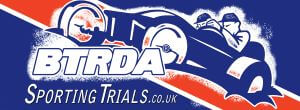Get Involved
The Basics
Sporting trials is the ultimate development of 2 wheel drive car trials and is unique as motor sports go. Like most trials, it's not about speed. The aim of a trial is to drive as far as you can over a laid out section without stopping. Each section is marked with poles to form a twisty route up a slippery hillside, sometimes sections will be so slippery that are unable to walk up it. To help each driver there is a passenger in the car who moves their weight around to get the best possible traction on each wheel. The further on a driver gets up a section the lower the score. The driver with the lowest score of the day is the winner.
On average the cars use engines that give about 100hp and even though the cars have rearward weight bias and low tyre pressures, the cars always have an excess of power over grip, and so delicate use of the gas is essential. As the Sporting Trials season is in the winter the events take place on surfaces that are slippery, muddy and uneven therefore requiring just the right amount of gas - too much gas and the wheels will instantly spin and loose traction, although sometimes a full blast of gas combined with fifth gear will be needed and in another instance a full blast of gas followed immediately by a delicate touch will be required, this is called "trickling".
The front wheels have an extreme steering lock enabling the car to turn in it's own length. Having said that the car would not be able to turn effectively without "fiddle" brakes, this is something that is peculiar to a sporting trial car. These brakes are controlled by individual levers in the cockpit that are connected to the rear left and rear right. This enables a unique kind of skid steer. When used together the steering and brake combined will enable the car to turn in it's own length. These fiddle brakes are also used to transfer the torque between the driving wheels so the fiddle brakes provide a dual role, not only to steer the car but also used as a manual traction control on the driving wheels.


How Does an Event Work
Think of a ski slalom in reverse and you won’t be far wrong. However unlike a ski event you are not against the clock. The main object is to get as far as possible through a series of gates (12 in all) over challenging terrain that rises and falls using a combination of your fiddle brakes throttle control and the right gear choice. You will need to do this on different hill layouts during the day over three rounds - anything from 24-30 hills in one day, giving the driver and passenger a full fun day of motor sport.
Entry level cars can range from as little as £1,500 - and of course you can spend more, but this is not a motor sport where the more money you spend the higher you will climb - this is all about skill.
Penalty points are given by marshals on each hill depending on where the car stops and can no longer gain forward momentum. The driver and passenger with the least amount of penalty points at the end of the day will be deemed the winners of the trial. There is a single classification of car (although many look different there are MSA rules governing the size and layout) and 3 classifications for drivers split into the type of rear axel the car has.
Red - Cosidered Experts
Blue - Intermediates
Rookie - Novices
Drivers not only compete against the whole field on the day but also against fellow drivers in their class. At the end of the season drivers may move up, down or remain in the same classification depending on his or her performance over the year.
There are season long championships and as well as an overall winner it is also split up into categories so everyone has the chance to compete against people of a similar skill level and similar cars.
The season starts in January, has a summer break from May and starts again in September, ending in December.

